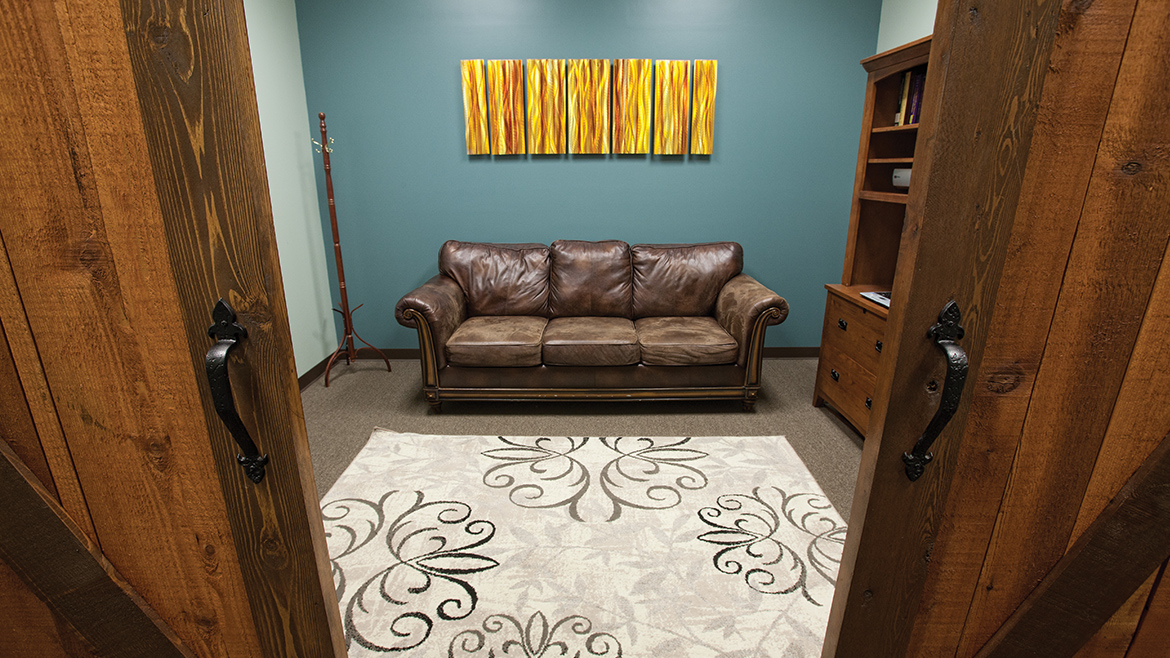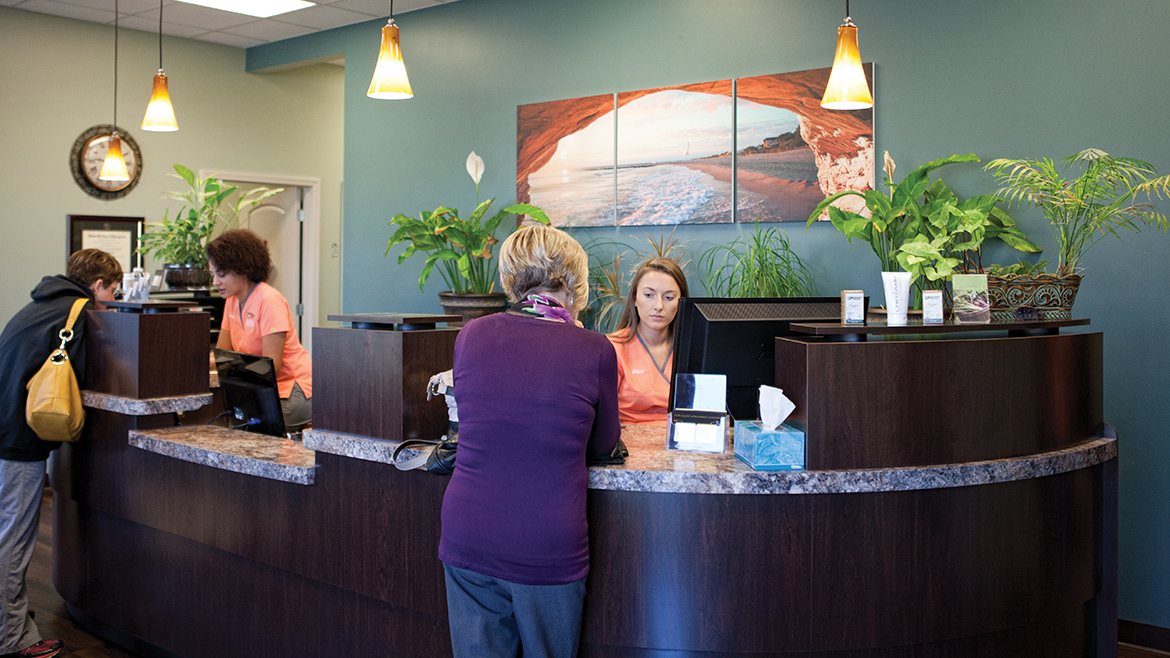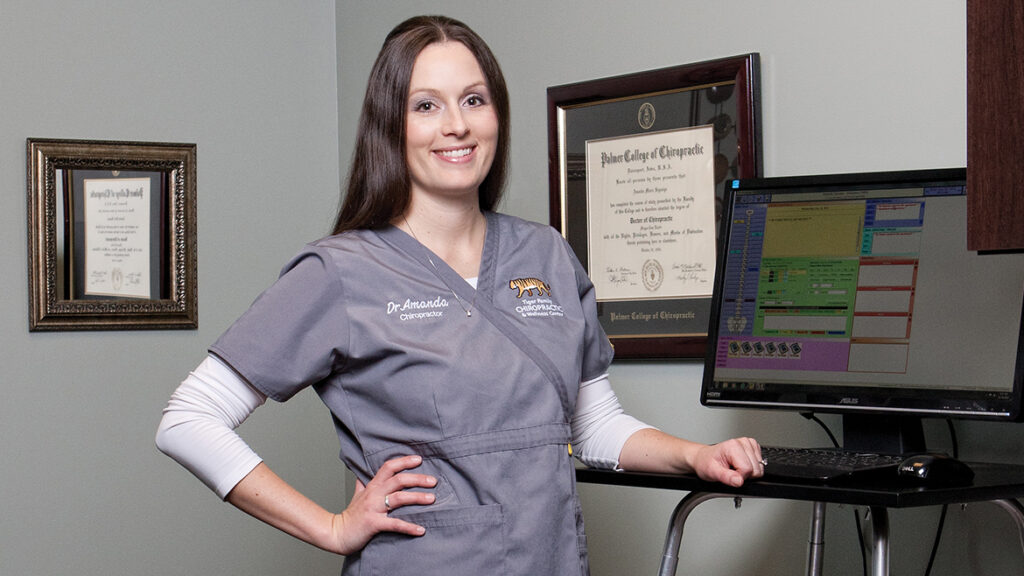Tiger Family transitions from mom-and-pop shop.
Tiger Family Chiropractic and Wellness Center has grown from door-to-door to new barn doors in nine years.
When owner Amanda Signaigo-Owens, DC, started in 2006, she didn’t have an office space, so she went right to her patients. “One family led to another family,” she says, “and I would visit them in their homes.”
So when she, her mother, Lucinda, and brother, Jon, opened the doors of their first office, off I-70 Dr. SE, in 2007, she thought the office space would be plenty. “It was huge,” she says. “It was everything I thought I’d ever need.”
The team grew that space from one room with two adjusting tables, building one wall at a time, until the office took the shape of a question mark with four adjusting rooms. The four-doctor team was bursting at the seams.
Signaigo-Owens says going from a literal question mark to an office built with purpose reflects their team goal: serving the best interests of the patient at each turn.
New Digs
The new space, more than 3,000 square feet and just up the street, at 3700 I-70 Dr SE, was built to suit and opened in April 2015. It holds seven adjusting areas with new adjusting tables; X-rays on site and a beverage station. The office also features handcrafted wooden barn doors into patient rooms and new furniture. Signaigo-Owens describes it as welcoming, open and more purposeful, and a facility that can better serve patients.
Signaigo-Owens says the team’s goal is for 80 percent of the population to be under chiropractic care, and they built the new space to reflect that purpose. It’s a space to fit the larger team. Jennifer Isringhausen, Melanie Gilbert and Blake McGrath round out the team of doctors, with plans to hire a fifth.

“I joke that it’s already too small, which is so silly to say, but literally, I feel like if we had more space we could fill it with more people getting better,” Signaigo-Owens says.
But physical growth isn’t the only thing on Signaigo-Owens’ mind this year. She says a change in team mentality has been taking place. When the office consisted of three people, they operated with an all-hands-on-deck, mom-and-pop-store mentality, and it worked for them. This year is all about changing infrastructure to support the 14.5-person staff.
They’ve restructured staff, and they’ve changed training protocols and patient care models. It’ll be an evolving process as the team continues to grow. Signaigo-Owens has focused on improving her management skills during the past year.
“I think the entrepreneurial side and the chiropractic side both require constant change and growth in order to maintain success at each new level,” she says. “I can’t imagine that I would have been prepared to handle what I am today 10 years ago.”
The year might present two different opportunities for growth, Signaigo-Owens says. She hopes to add a second location in Columbia. She’s also considered expanding to 24 hours a day.
“I don’t have an answer yet,” she says. “But we’ll see how it shapes out.”
Grassroots Mentality
There’s still work to be done to get 80 percent of the community under some sort of chiropractic care. And the nature of the industry means constantly looking for new clients.
“Our goal is to take somebody who has an issue or condition, work them through that injury, that condition, getting them to a point where they’re stabilized with care, and then starting them out to where they’re not here all the time,” Signaigo-Owens says. “So that creates for us a constant need to have new patients come in.”

She says their goal is to have patients follow their wellness plans, whether being treated for a specific injury or on a maintenance plan. Showing patients X-rays a year later that shows a straighter, healthier spine helps people understand the value of chiropractic care.
She says her goal, and the industry’s as a whole, is to transition from pain relief care to preventative care. And that involves a mind shift in the population away from the “tough it out” mentality.
“I really honestly think we’re some time away from people knowing that they have to take care of their spine the same way they take care of their teeth and the rest of their body,” Signaigo-Owens says. “None of us were raised to think that way.”
That shift in thinking is a grassroots effort, Signaigo-Owens says. To start that campaign, the Tiger Family team teaches classes on preventative care.
Today, everyone understands how to care and maintain teeth. “I try to picture what the dentists must have done if we were to go back in time and there was a time when people would never go to the dentist,” Signaigo-Owens says.
The chiropractic industry is healthy and growing in Boone County, Signaigo-Owens says, thanks to the large population seeking out alternative health care. She says that could be due to the young population, the amount of health care industry in the area or the generally healthy and active community.
“We have a great group of chiropractors that are in the Columbia area, and I think that really helps to increase its popularity and help people to expect it as an option and even seek it out before anything else when they feel like something’s going on [physically],” she says.

The U.S. Department of Labor has projected that chiropractor jobs will increase 17 percent from 2014 to 2024. The average growth rate for all occupations is 7 percent. The Milbank Quarterly, a journal studying health and health policy, says that in 2015 there were almost 100,000 chiropractors, a level similar to the number of practicing family physicians. That indicates a 50 percent increase in the number of chiropractors since 1990.
Boone County seems to be a good fit for an industry that, at its core, helps individuals move better. And the variety of chiropractic professionals in the area allows the industry to thrive.
“The doctors that are here, that are practicing, respect one another,” Signaigo-Owens says. “And we know that we do things differently, but there’s this camaraderie that, ultimately, we know that chiropractic care works, even if I do it a little differently than you do in terms of the art of how we express that.”








